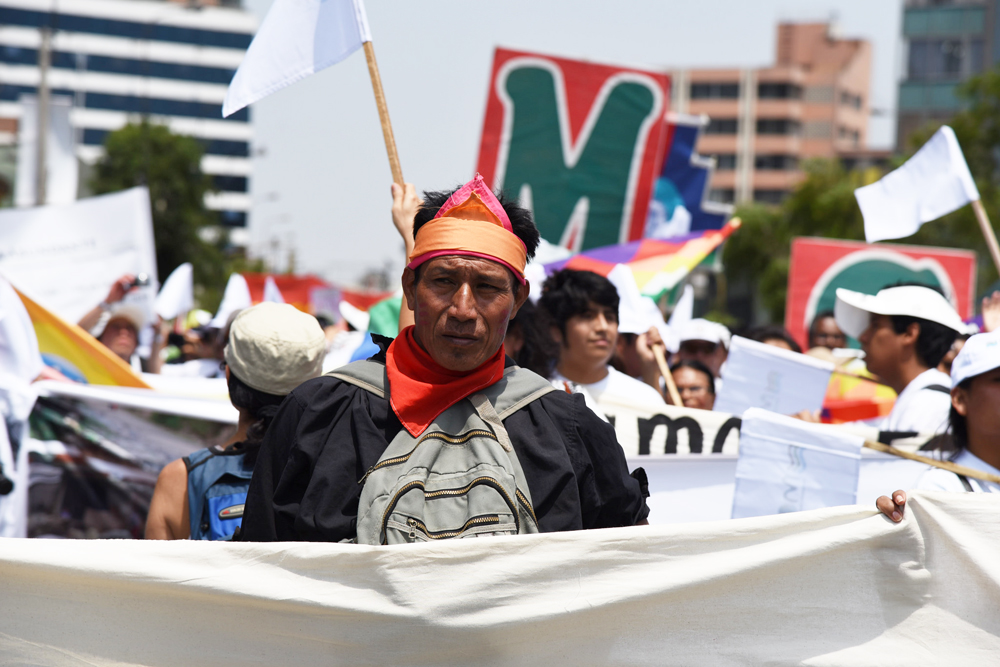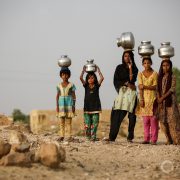Water Left Out Of Lima Climate Negotiations
A month after water supply was a central feature of a U.S. – China agreement, formal recognition of water scarcity and access is still elusive.

By Codi Kozacek
Circle of Blue
Exactly one month after the United States and China signed a landmark climate change agreement that focused on water supply and water quality in two of its six major provisions, negotiators at the international climate conference in Lima, Peru were silent on the subject.
The word ‘water’ is not mentioned once in the five-page agreement signed in Lima on December 12 at the close of the 20th session of the Conference of the Parties (COP), an annual meeting that brings together all 195 countries within the United Nations Framework Convention on Climate Change (UNFCCC). The talks were the last major negotiations to take place before a meeting of the countries in Paris in December 2015, when a binding global climate deal is expected to emerge.
The breakthrough in diplomacy that is expected to lead to the Paris climate accord is the U.S. – China climate pact, signed last month, and driven in large part by new science and ground level awareness globally that most of the planet’s major energy and grain-producing regions are getting drier. That knowledge, though, evaded negotiators in Peru despite the efforts of the global water community to include water in the official diplomatic text—a goal that first rose to prominence at the 2009 U.N. climate conference in Copenhagen.
–Karin Lexen, Director of World Water Week and Prizes
Stockholm International Water Institute
“From our perspective I can say, unfortunately, so far water does not play a central role in the negotiations,” Maika Muller, programme officer for the Global Water Partnership, told Circle of Blue. “It is recognized by the parties, but it is not explicitly mentioned in the decisions or the agreement, although we all know it is a common thread in climate impacts expressed by extreme events like floods and droughts.”
Instead, the negotiations have focused single-mindedly, and narrowly, on capping greenhouse gas emissions, even as climate change is being experienced most acutely through melting glaciers that dry up water supplies, record-breaking droughts that decimate food supplies and hinder energy production, and massive storms that are more deadly and expensive than ever.
More recognition of the connections between water supply, water quality, water conservation, and climate change is not enough to prompt deeper discussions at U.N. climate summits, according to water policy experts. They warn that failing to formally take water into account could ultimately undermine efforts to both mitigate and adapt to climate change. For example, without formal recognition, water management projects necessary for sustainable cities, agriculture and energy are largely cut out of initiatives like the Green Climate Fund. Renewable energy strategies and efforts to stop deforestation also have important intersections with water, and must be designed with water in mind, experts say.
“If you don’t appreciate and recognize the role of water, then our firm belief is that you will not be able to sustain climate action,” Karin Lexen, director of the World Water Week and Prizes Department at the Stockholm International Water Institute (SIWI), told Circle of Blue.
No Action Despite Recognition of Water’s Importance
Until Lima, water issues were rising in the global diplomatic community. Water made progress within the official framework last year, at the COP19 meeting in Warsaw. There, water was included as one of four focus areas of the Nairobi Work Programme, an initiative created in 2005 to develop and spread knowledge that can inform climate adaptation efforts.
But it’s been a slow ascent. Water has not been incorporated fully into key programs like the Green Climate Fund, established at the 2010 COP in Mexico City to help countries combat climate change.
“Water is only under the Green Climate Fund, so far, as an impact indicator for WASH, but there is not a stand-alone focus on water resource management,” Muller said. “If a water window is created under the Green Climate Fund, it will increase the attention by the parties and the negotiators to put water on the climate agenda. It would also allow developing countries to raise money for resource management and prepare for climate risks that occur by water.”
Though diplomats are reluctant to guide water into global climate negotiations, water is increasingly recognized as an important element in UNFCCC program activities, such as the Nairobi Work Programme. The Work Programme assists countries in understanding how climate change will affect them, and how they can adapt.
“The major barrier for [a program focused on water] was not that negotiators didn’t feel that water is important, but having yet another program, yet another issue that needed to be negotiated,” Lexen said. “I think this is one of the problems.”

The Danger of Ignoring Water
Leaving water out of official negotiations, however, will likely be detrimental to the programs and initiatives that are included. Water experts identified problems likely to arise in both mitigation and adaptation measures—the ability to keep the worse effects of climate change from happening and the ability to adjust to new climate realities, respectively.
Mitigation, which focuses on either reducing emissions or capturing emissions that have already been released, is an area where water has been especially absent.
“Mitigation has been very much about the economy, about calculations,” Lexen said. “The people involved in mitigation have been very far away from the water community, when really more effects are showing that if you don’t deal with water, you will not be able to solve this issue.”
For example, a scientific study published in February found that the Amazon rainforest has the potential to become a source of carbon emissions in drought years, while in wet years it can take more carbon out of the atmosphere, reducing global emissions. In other words, focusing solely on stopping deforestation will not necessarily lead to carbon reductions. Water must be taken into account, too.
–John Matthews, Coordinator
Alliance for Global Water Adaptation
Similarly, efforts to produce renewable energy and build clean energy infrastructure are largely dependent on water. Hydropower dams may not produce energy effectively if they are not built with changing water realities in mind, while the production of biofuels also relies on adequate water supplies. Failure to address these issues could put large investments at stake, as well as jeopardize the capacity to adapt to climate change if decisions made for mitigation lock in certain water consumption patterns that last decades, according to John Matthews, coordinator of the Alliance for Global Water Adaptation (AGWA).
“A lot of people at work on clean energy don’t see water yet,” Matthews told Circle of Blue.
Taking water into consideration is also necessary for effective adaptation initiatives, according to Sonja Koeppel, environmental affairs officer with the Convention on the Protection and Use of Transboundary Watercourses and International Lakes at the United Nations Economic Commission for Europe (UNECE). In a river basin, for example, expensive adaptation measures to combat increasingly severe flooding in downstream areas may be unnecessary if funding can be mobilized and coordinated to address the roots of the problem upstream.
“These things are still very little considered at UNFCCC,” Koeppel said. “When it comes to transboundary river basins, it is necessary to have some sort of coordination and cooperation on these adaptation measures at the basin level.”
A Growing Coalition Around Water Issues
While formal inclusion of water in the negotiations has remained elusive, the water community has been successful in elevating the number and diversity of people talking about water and climate.
“On the one side, if you are looking into the text on the table right now, you will not find water much more than in 2009,” Lexen said, referring to the draft text for Paris and the text from the Copenhagen agreement. “But if you enter into a discussion with the negotiators and those working with the UNFCCC, they would say ‘yes, we appreciate that water is really important, and we need to have you guys here.’”
Between the Copenhagen conference and the Lima conference, many decision makers have shifted their views of water from a narrow, niche infrastructure sector. Water is now viewed as a common theme encompassing major areas like agriculture and energy, according to Matthews.
“Five years ago, when we talked about water we were just trying to make the basic case that water was essential to thinking about climate adaptation,” Matthews told Circle of Blue. “Water has really become recognized as the medium through which climate change impacts occur, such as droughts, floods, tropical cyclones, and extreme storms. All of that in effect shows that the language of water is really the language of climate change impact.”

Matthews said another major difference is the level of engagement he saw in Lima. Water side events attracted the attention of high-level government officials and heads of organizations such as the UN Intergovernmental Panel on Climate Change (IPCC). It was a marked change from Copenhagen, where Matthews recalled an event where one man said he was the only representative out of a 600-strong delegation from Brazil who was dedicated to water.
“I think what was catalyzed in Lima is a much broader coalition,” Matthews said. “Water caught fire. Water has moved out of the water community as an important agenda item. It is being talked about by people who cannot be labeled as simply coming out of the water community and advocating for their interests.”
Key Goals for Water in 2015
Matthews and others in the water community hope this broad coalition can take advantage of three important meetings next year to pursue the inclusion of water and climate issues at the international level. In addition to the Paris COP in December, two other major events—the World Conference on Disaster Risk Reduction in March and the Sustainable Development Goals summit in September—offer opportunities for negotiators to place water on the agenda.
“Despite a lack of the presence of water in the [Lima] discussions, we are hopeful for next year when so many important events will happen, and new agreements and frameworks will be developed,” Anna Kaplina, environmental affairs officer with the Convention on the Protection and Use of Transboundary Watercourses and International Lakes at UNECE, told Circle of Blue. “We do hope that water will take a much more prominent place in those agreements and discussions.”
–Sonja Koeppel, Environmental Affairs Officer
United Nations Economic Commission for Europe
Some of the major goals identified by water experts include:
- Integrating water into discussions of both climate change mitigation and adaptation. For example, taking into consideration the water used to generate renewable energy, or by forests that store carbon in plants and soil.
- Including water resource management projects in the Green Climate Fund, and allowing these projects to work at the regional, river-basin level.
- Passing a comprehensive Sustainable Development Goal for water, including not just water and sanitation access targets (WASH) but also a target for integrated water management.
- Addressing water issues coherently in all three major international negotiations—the Disaster Risk Reduction conference, the Sustainable Development Goals summit, and the Paris COP21 conference.
- Translating on-the-ground water knowledge and action into the international negotiations and global policy discussions.
- Continuing to build upon the community mobilized around water issues at the Lima COP20.
“We will have to see in reality how this can be done and how realistic it is in the next year,” Koeppel said. “In the end it will have to be the countries speaking up for this topic.”
A news correspondent for Circle of Blue based out of Hawaii. She writes The Stream, Circle of Blue’s daily digest of international water news trends. Her interests include food security, ecology and the Great Lakes.
Contact Codi Kozacek









Leave a Reply
Want to join the discussion?Feel free to contribute!